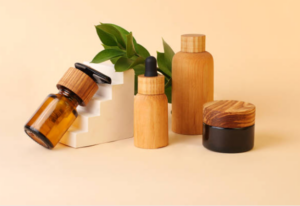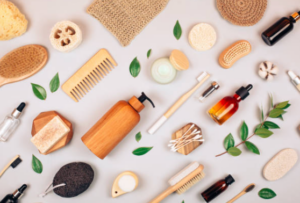Green Beauty 101

In a world that is increasingly conscious of its environmental impact, the beauty industry is not exempt from scrutiny. Consumers are becoming more aware of the ingredients in their beauty products, as well as the ethical practices of the brands they support. This shift in mindset has led to the rise of green beauty – a movement that promotes sustainability, cruelty-free practices, and mindful consumption. In this beginner’s guide to green beauty, we’ll explore what it means to embrace eco-friendly beauty products and how you can make informed choices for a more sustainable and cruelty-free beauty routine.
Understanding Green Beauty
In the vast landscape of the beauty industry, green beauty emerges as a beacon of sustainability and ethical practices. To embark on a meaningful journey into green beauty, it’s crucial to delve into the fundamental principles that guide this movement. Let’s explore the key aspects that define green beauty and set it apart from conventional beauty practices.
Clean Ingredients: The Heart of Green Beauty
At the core of green beauty lies a commitment to clean ingredients. This means embracing formulations that are free from harmful chemicals such as parabens, sulfates, phthalates, and synthetic fragrances. Green beauty products are carefully crafted with a focus on natural, non-toxic substances derived from plants, fruits, and minerals.
The avoidance of toxic chemicals is not only beneficial for your skin but also contributes to environmental preservation. Harsh chemicals found in conventional beauty products can have adverse effects on ecosystems when they are washed away and enter water sources. By choosing green beauty, you prioritize the health of your skin while minimizing your impact on the planet.
Cruelty-Free Practices: A Compassionate Approach to Beauty
Central to the ethos of green beauty is a firm stance against animal testing. Cruelty-free practices mean that products and their ingredients are not tested on animals at any stage of development. This commitment reflects a compassionate approach to beauty, acknowledging that the well-being of animals should never be compromised for the sake of human cosmetic preferences.
Cruelty-free beauty is not just about avoiding harm; it’s also about supporting brands that actively promote alternatives to animal testing. Green beauty enthusiasts seek out products that bear cruelty-free certifications, such as the Leaping Bunny logo or PETA’s cruelty-free certification, ensuring that their purchases align with ethical standards.
Sustainable Packaging: Reducing the Beauty Industry’s Footprint
As consumers become increasingly conscious of the environmental impact of packaging, green beauty brands are taking steps to address this concern. Sustainable packaging is a cornerstone of the movement, emphasizing the importance of minimizing waste and adopting eco-friendly materials.
Brands committed to green beauty often opt for packaging made from recycled materials, encouraging a circular economy. Additionally, the use of biodegradable materials and innovative refillable packaging options further reduces the environmental footprint of beauty products. By choosing green beauty, you actively participate in the reduction of plastic waste and contribute to a more sustainable future.
Green beauty prioritizes ingredient transparency, empowering consumers to make informed choices about the products they use. Reading labels becomes a key skill in navigating the beauty aisle. Here are some ingredients commonly found in green beauty products:
Organic Botanicals: Green beauty often harnesses the power of nature through the inclusion of organic botanicals. Ingredients like aloe vera, chamomile, and lavender provide skincare benefits without the use of synthetic chemicals.
Cold-Pressed Oils: Instead of relying on harsh extraction methods, green beauty favors cold-pressed oils. These oils retain their natural goodness and are rich in vitamins and antioxidants. Examples include jojoba oil, argan oil, and rosehip oil.
Essential Oils: Natural fragrances are achieved through essential oils, which not only add a delightful scent but also offer various therapeutic properties. Lavender, tea tree, and peppermint are popular choices in green beauty formulations.
Minerals and Clays: For makeup products, green beauty often incorporates minerals and clays to achieve pigmentation without the need for synthetic colorants. These ingredients are gentle on the skin and provide a natural, radiant finish.

Transitioning to a Green Beauty Routine
Transitioning to a green beauty routine is a rewarding journey that not only benefits your skin but also aligns with your values of sustainability and ethical consumption. In this chapter, we’ll explore practical steps and considerations to guide you through the process of incorporating green beauty into your daily regimen.
Assessing Your Current Beauty Products
Before embarking on your green beauty journey, take stock of your current beauty products. This step involves scrutinizing the ingredient lists of your skincare, haircare, and cosmetic items. Look for common ingredients that may be considered harmful, such as parabens, phthalates, and synthetic fragrances.
Make note of the products you use most frequently or those that cover large surface areas, as these are good starting points for transitioning. Assessing your current products allows you to make informed decisions about what to keep, what to replace, and what to prioritize in your transition to green beauty.
Educating Yourself About Green Beauty Brands
Green beauty is a diverse and growing market with a plethora of brands offering clean, sustainable, and cruelty-free products. Educate yourself about these brands to make informed choices aligned with your values. Look for brands that prioritize transparency, ethical sourcing, and environmentally conscious practices.
Explore the ethos of green beauty brands by visiting their websites, reading customer reviews, and checking for relevant certifications. Certifications such as USDA Organic, COSMOS Organic, and cruelty-free logos can serve as reliable indicators of a brand’s commitment to green and ethical principles.
Setting Priorities for Transition
Transitioning to a green beauty routine doesn’t have to be an all-or-nothing process. Setting priorities based on your preferences and needs can make the transition more manageable. Consider focusing on specific product categories or items you use daily. Here are some common priorities for transitioning to green beauty:
Skincare: Prioritize replacing your daily skincare products, such as cleansers, moisturizers, and serums. Transitioning to natural and organic alternatives can nourish your skin without exposing it to harmful chemicals.
Makeup: Begin with the products that cover larger areas of your face, such as foundations, concealers, and powders. Green beauty brands offer a wide range of makeup options formulated with clean ingredients.
Haircare: Transitioning to green haircare involves replacing shampoos, conditioners, and styling products. Look for brands that prioritize plant-based ingredients to promote healthy hair without compromising on performance.
Deodorant: Switching to a natural and aluminum-free deodorant is a common priority for many individuals. Green beauty brands offer effective alternatives that keep you feeling fresh without the use of harmful ingredients.
Exploring DIY Beauty
Embrace the simplicity and creativity of DIY beauty as part of your green beauty journey. Creating your skincare treatments using natural ingredients allows you to customize products tailored to your skin’s unique needs. Common DIY beauty ingredients include:
Coconut Oil: A versatile ingredient with moisturizing and antibacterial properties, suitable for use in cleansers, moisturizers, and hair masks.
Honey: Known for its antibacterial and hydrating properties, honey can be used in face masks, cleansers, and hair treatments.
Aloe Vera: Soothing and hydrating, aloe vera is excellent for sunburn relief and can be incorporated into DIY facial masks and hair treatments.
Essential Oils: Add fragrance and therapeutic benefits to your DIY creations with essential oils like lavender, tea tree, and rosemary.
Exploring DIY beauty not only reduces your reliance on commercial products but also minimizes packaging waste and allows you to connect more intimately with your skincare routine.

Embracing Minimalism in Beauty
Green beauty often aligns with a minimalist approach, emphasizing simplicity and effectiveness. Embrace this philosophy by streamlining your beauty routine to include only essential products. Consider multifunctional products that serve multiple purposes, reducing the overall number of items in your beauty arsenal.
Multi-Use Products: Opt for products that can be used for various purposes, such as a tinted moisturizer with SPF, which combines sun protection with light coverage.
Capsule Wardrobe: Apply the concept of a capsule wardrobe to your beauty routine by selecting versatile products that work well together and meet your specific needs.
Quality Over Quantity: Prioritize high-quality products with clean ingredients over accumulating a large number of products. This approach not only simplifies your routine but also reduces consumption.
Gradual Transition and Patience
Transitioning to a green beauty routine is a gradual process that may take time. It’s okay to replace products one at a time as you finish them, allowing you to research and choose suitable alternatives. Patience is key, and understanding that the journey is ongoing can help you make sustainable and long-lasting changes.
Sample Sizes: Experiment with sample sizes or travel-sized versions of green beauty products before committing to full-size purchases. This allows you to test compatibility with your skin and assess the effectiveness of the product.
Skin Adjustment: Your skin may undergo an adjustment period as you switch to new products. Be patient and allow your skin time to adapt to the natural ingredients. If needed, consult with skincare professionals for guidance.

Cruelty-Free Beauty Brands
A significant aspect of green beauty is the commitment to cruelty-free practices. Many reputable brands have taken a stand against animal testing, offering a wide range of high-quality products. Here are some cruelty-free beauty brands that exemplify the principles of green beauty:
- Lush: Known for its vibrant and innovative products, Lush is a cruelty-free brand that prioritizes ethical sourcing of ingredients. From bath bombs to skincare, Lush offers a wide array of green beauty options.
- 100% Pure: Joining the ranks of cruelty-free beauty brands, 100% Pure stands out for its commitment to creating products that are not only kind to animals but also harness the power of natural ingredients.
- Tata Harper: This luxury skincare brand focuses on natural and non-toxic ingredients. With a commitment to sustainability, Tata Harper’s products are housed in recyclable glass packaging.
- Dr. Bronner’s: Renowned for its castile soap, Dr. Bronner’s is a family-owned brand with a long history of commitment to sustainability and fair trade practices. Their products are versatile and can be used for various beauty and household needs.
The beauty industry generates a significant amount of plastic waste, and green beauty aims to address this issue through sustainable packaging solutions. Brands are adopting innovative approaches to reduce their environmental impact:
- Refillable Packaging: Many green beauty brands offer refill options for their products. This encourages customers to reuse existing containers, reducing the need for new packaging.
- Biodegradable Materials: From packaging peanuts to product containers, some brands are exploring biodegradable materials that break down naturally, minimizing their impact on the environment.
- Recyclable Packaging: Opting for materials that are easily recyclable is a common practice in green beauty. Brands provide clear instructions on how to recycle their packaging to make the process easier for consumers.
- Minimalist Packaging: Green beauty often embraces minimalist packaging, reducing excess materials and focusing on the essentials. This not only looks sleek but also contributes to a more sustainable approach.
Embarking on a green beauty journey is not just about adopting a trend; it’s a lifestyle choice that reflects a commitment to the well-being of the planet and its inhabitants. By understanding the principles of green beauty, making informed choices about ingredients, and supporting cruelty-free brands, you can contribute to a more sustainable and ethical beauty industry. Remember that the transition doesn’t have to happen overnight; small, intentional changes in your beauty routine can have a meaningful impact over time. Green beauty is not just a destination; it’s a continuous journey towards a more conscious and compassionate approach to self-care.

